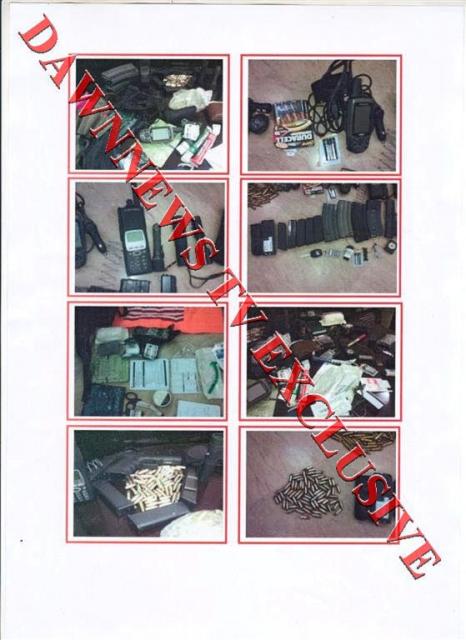The mystery surrounding Raymond A. Davis, the American former Special Forces operative jailed in Lahore, Pakistan for the murder of two young motorcyclists, and his funky “security” company, Hyperion-Protective Consultants LLC, in the US continues to grow.
When Davis was arrested in the immediate aftermath of the double slaying in a busy business section of Lahore, after he had fatally shot two men in the back, claiming that he feared they might be threatening to rob him, police found business cards on him for a security company called Hyperion-Protective Consultants LLC, which listed as its address 5100 North Lane, Orlando, Florida.
A website for the company gave the same address, and listed the manager as a Gerald Richardson.
An investigation into the company done for Counterpunch Magazine that was published on Tuesday, disclosed that the address was actually for a vacant storefront in a run-down and almost completely empty strip mall in Orlando called North Lane Plaza. The 5100 shop was completely empty and barren, save for an empty Coke glass on a vacant counter.
Now Tom Johnson, executive of a property company called IB Green, owner of the strip mall property, says that the 5100 address was rented by a man named Gerald Richardson, who used it to sell clothing. “We made him move out in December 2009 for nonpayment of rent,” he says. Johnson recalls that at one point when Richardson was leasing the space for his clothing store, he told him, “Oh, I have another company called Hyperion which might get mail there.”
Hyperion-Protective Consultants LLC, as reported in the Counterpunch article, is not registered with the Florida Secretary of State’s office, although it still lists the vacant 5100 North Lane, Orlando address as its headquarters on the company website, which also provides an email address for Richardson, who is described as the company’s “manager and chief researcher.” (Efforts to reach Richardson via his email and by leaving a message on the one functioning number listed on the website have gone unanswered.)
But there are other mysteries here, too, regarding Davis (whose name does not appear on the Hyperion-Protective website), and regarding Hyperion.
 Just a security guy? Guns, shells, clips, multiple cell phones and batteries all found in Davis's possession by police
Just a security guy? Guns, shells, clips, multiple cell phones and batteries all found in Davis's possession by police
As reported today in the New York Times in an article by Jane Perlez, there is also a company in Las Vegas Nevada called Hyperion Protective Services. That firm’s 2006 registration information lists as its owners Raymond A Davis and his wife Rebecca J. Davis of 9811 W. Charleston St., Las Vegas, Nevada, 89117. It lists the company’s address as 9345 Boulder Opal Ave., Las Vegas. A registration in Nevada of that name says that Gerald Richardson “founded the firm” in 1999. In an curious twist though, Channel 7 News in Denver, a local ABC affiliate, has learned that Davis and his wife, the two listed principals of the company, actually live in Highland Ranch, Colorado, which would be a fair commute to Vegas.
This company, which Perlez says claims it at least hopes to win government contracts, advertises its services (basically providing due diligence for companies making property purchases, and running background checks on employees), on a website called LasVegasComplete.com. On that site, it lists its website, which is the same original site for Hyperion-Protective Consultants, LLC, the apparently virtual company that borrowed the mail address of Gerald Richardson’s clothing shop at 5100 North Lane, Orlando until he couldn’t pay the rent and got evicted, and that doesn’t have a listed number, or a person to answer the phone. One reason may be that it may no longer exist. Lee Rivers, an official of the Florida Secretary of State’s office on says that the company was registered back in before 2008 as Hyperion-Protective Consultants LLC, but that it was dissolved that year for “failing to file a report with the Division of Corporations.” Rivers notes that it is illegal for a company to “hold itself out as a Florida Corporation,” when it is not actually one.
Meanwhile, the phone number listed for the Nevada incarnation of Hyperion-Protective is a cell phone with a Tucson, Arizona area code, which is registered to Raymond A. Davis. A call to that phone reached a recording of a male voice, with no mention of Hyperion-Protective, and no name offered, asking for call-back information. The call was not returned.
Perlez in her article, datelined Lahore, Pakistan, at least for the first time mentions the forensic evidence that both of Davis’s victims were shot in the back and the back of the head, and quotes police as saying that Davis had told them he shot the men not because they had menaced him with guns, as has earlier been asserted in the US media, based on misleading statements from the State Department, but because “he believed that the men were armed.” (According to a witness, the shot to the head was fired execution-style at one of the wounded men by Davis after he exited his car.)
If that was the accepted standard for shooting someone in Texas or Arizona, half the residents of the state would be shooting the other half. It’s also a pretty lame justification for shooting two people in the back!
Perlez also confirms another point–the suspicious array of items that police found in Davis’s rented Honda Civic when they arrested him–though she diminishes their significance by offering the snide comment that the local Pakistani press has been “dwelling” on the items, as well as on his various, and mutually exclusive array of business cards, which included one listing him as working out of the Peshawar Consulate, on the edge of the Pashtun Tribal area, one listing him as a Defense Department contractor, and one listing him as an employee of the seemingly non-existent Hyperion-Protective Consultants LLC in Orlando.
The items that the Pakistani press are “dwelling” on though, as listed by Perlez, include a Glock handgun, a flashlight that attaches to a headband, and a pocket telescope. Unmentioned by Perlez, but also found by police in Davis’s car, were a large number of cellphones, including at least one satellite phone, a cellphone tracker, a collection of batteries, bucketloads of bullets, both for the Glock and a Beretta allegedly used by Davis to kill the two motorcyclists in his pinpoint shots through his front windshield, and a load of M-16 shells. Police report that the bullets were high-powered killer projectiles not allowed in many countries. There were military-grade knives, wires, wire cutters, and a surprising array of high-capacity magazines for the handguns, too (like the one used to such devastating effect in the recent Tucson massacre that killed several people and left Congresswoman Gabrielle Giffords with a serious brain injury). and, reportedly, also some very odd items for a “consular official” to be carrying: masks and makeup.
There were also some other things police found that are profoundly puzzling and disturbing: masks and make-up, and a camera loaded with pictures of dozens of madrassas (religious schools) and other religious buildings around Lahore, as well as with photographs of Pakistani military installations, some on the critical borders with India and Afghanistan. The photos have reportedly led prosecutors to ask that espionage be added to the list of charges facing Davis.
This was not the run-of-the-mill office equipment one would expect for an embassy security officer (one of the various titles (covers?) that the State Department has claimed for Davis at the Lahore Consulate).
The US, which seems to desperately want this guy out of Pakistani hands, is reportedly threatening to cut off financial assistance to Pakistan and to cancel a planned visit by President Obama if Davis is not released–pretty heavy pressure for a low-ranking consular contractor–especially one who has admitted he shot two locals to death while apparently not working in any official capacity.
Perlez also uncritically parrots the US government’s line that Davis is “protected by diplomatic immunity under the Vienna Conventions and that he must be released from custody.”
The problem, as I reported in my earlier Counterpunch article, is that Vienna Convention that Perez and the US government are relying on to demand his release states very clearly that any immunity for diplomats or consular staff does not apply to “serious crimes,” and it would be hard to imagine a more serious crime than a double murder, which is what Davis is currently being charged with.
What seems clear at this point is that Davis, 36, is not what the US government is now claiming he is: a “technical advisor” to the consulate. That geeky description is belied by the eight or more perfect shots that he put, rapid-fire, into the two motorcyclists, shooting through the front windshield of his car.
 The tight pattern of bullet holes in the windshield shows the precision of Davis's shots at his victims.
The tight pattern of bullet holes in the windshield shows the precision of Davis's shots at his victims.
His record –10 years in US Special Forces, supposedly ending in 2003–and his shell “security” company in the US, with its faked addresses, suggest strongly that he is working for the US, either in some intelligence branch, or more likely as an employee of some mercenary-for-hire company like Xe (Blackwater). In fact, a former long-time Army Special Forces veteran familiar with black-ops, speculates that Davis may still be in the Special Forces. He says, “Consider the strong possibility of our man being active-duty military, not Agency, not contract. Military people from special units have more and more taken responsibility for covert ops, especially those that involve shooting.”
This veteran adds, “Military folks are sometimes given an “official” cover, ie, a diplomatic
passport and some BS story about what they do (consular section, eg). This is a problem, because it violates agreements with the host nations about reporting how many military are in country, and covers some sensitive operations. Thus the panic of the Department of State et al right now.”
What Davis was actually doing on his ill-fated drive into the commercial heart of Lahore when things went wrong is up for grabs.
There have been several reports in the Pakistani press, unmentioned by Perlez, that the two men he killed were not, as initially reported by the US, petty thieves, but were actually agents working for Pakistan’s intelligence service, the ISI. Today, ABC’s Nick Schifrin, who has been the best reporter on this story in the US corporate media, reports that while the State Department “adamantly denies” the claim (big surprise, that!), four Pakistani officials, off the record, have told ABC that the two men Davis killed were ISI agents assigned to tail Davis because he was a spy who ISI felt had “crossed a red line.”
What “red line” might that be? Again there is further speculation in Pakistan’s media that Davis, instead of simply gathering intelligence, may have been involved in some kind of covert US program to actually finance or orchestrate some of the bombings that have been rocking, and destabilizing Pakistan. (Certainly that could be an explanation for the stop at the ATM for a bundle of cash, and for all of those cell phones recovered from Davis’s car and person, which could serve nicely as bomb detonators–a popular method adopted by terrorists everywhere– though of course they could also have been dedicated lines or throwaways for “cutouts,” as one veteran of such black-ops notes.)
The suicide by rat poison of the 18-year-old bride of one of the two slain men would seem to point to the victim’s being more than just a petty street thief, too. The young woman, from her hospital bed, before dying, said that she was killing herself because she despaired of seeing justice done for the murder of her husband.
